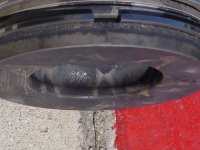COMP461
Comp Diesel Sponsor
- Joined
- Apr 23, 2006
- Messages
- 4,009
I believe that the fuel should never get a chance to reach the outer wall. The pressure of the CR system and the size of the injector, and timing should if all is optimal have the fuel burn 100 % of the fuel should burn , the smoke show is due to late fueling , and to big of a fuel delivery at the wrong time. You always hear, that “it cleaned up, when the turbo lit “well done right there should be very little to no smoke. The CR injection lends itself to giving the optimal timing to help spool a charger, this is not possible with a fixed timing P pump, so excessive fuel is delivered; this excessive fuel is the problem with the pistons getting fuel impingement.
With designing a optimal piston crown, I believe that you should look at the optimal injector pattern, and then fill any area in with aluminum that the injector is not fueling. A flat bottom to a piston bowl is having a dead area .
With designing a optimal piston crown, I believe that you should look at the optimal injector pattern, and then fill any area in with aluminum that the injector is not fueling. A flat bottom to a piston bowl is having a dead area .

